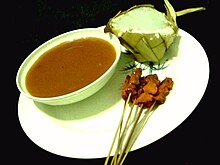Translations:Filipino cuisine/128/en
Mindanao


In Mindanao, the southern part of Palawan island, Sulu and Tawi-Tawi, dishes are richly flavored with the spices common to Southeast Asia: turmeric, coriander, lemon grass, galangal, cumin, zest and/or leaves from varieties of native limes, cinnamon, and chillies—ingredients not commonly used in the rest of Philippine cooking. The cuisine of the indigenous ethnolinguistic nations who are either Christian, Muslim or Lumad peoples of Mindanao and the Sulu archipelago has much in common with the rich and spice-paste centric Malay cuisines of Malaysia and Brunei, as well as Indonesian and Thai cuisine, and other Southeast Asian cuisines. Mindanaoan cuisine represents the cultural achievements of prehispanic Philippine cuisine in other most parts of the country immediately prior to Spanish colonization between in the late 16th to early 17th centuries. Hints of similar dishes and flavors can also found in the Bicol region and the Cordilleras, which still prefer a coconut and spice-paste rich palate similar to Mindanao.